Last updated: August 27, 2020
Article
The Remarkable Roscoe, Part III
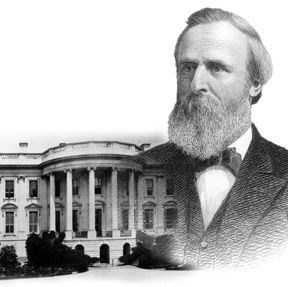
Rutherford B. Hayes Presidential Center
Even though Conkling’s supporters endorsed reform at the 1877 New York Republican Convention, he thrashed reformers verbally, suggesting that they were amateurs, phonies, or hypocrites. He referred to the Civil Service as the “Snivel Service,” and called supporters of reform “man milliners,” who paraded “their own thin veneering of superior purity” while attacking Grant. “Their stock in trade is rancid, canting self-righteousness,” he said.
Yet, despite all the self-interested antagonism that he directed at Hayes, he still agreed with the President on important monetary policy matters. He stood with Hayes in opposition to the Bland-Allison bill, which called for the remonetization of silver. He called this an idea of “a nearly equal mixture of idiots and knaves.” Conkling voted against the measure, but failed to do anything to prevent a Senate override after Hayes vetoed it, and Bland-Allison became law.
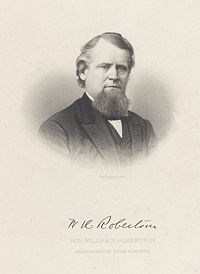
Wikipedia.com
Conkling also stood with Hayes in the matter of “riders” to appropriations bills. In 1879, House Democrats attempted to “de-fund” the U.S. Army; to prevent it from “interfering” with Congressional elections in the South. Five times the Democrats attached such riders to appropriations bills, and five times Hayes vetoed them. Conkling supported Hayes every time, denouncing the efforts to compel Hayes “to give up his convictions, his duty, and his oath, as the price to be paid a political party for allowing the Government to live.”
But these were rare moments of good will. When the presidential election year of 1880 came around, he was anxious to replace the retiring Hayes with former president Grant. His support for Grant began in February 1880, soon after the latter’s return from a much publicized and praised trip around the world. Conkling led a pro-Grant majority at the New York state convention. It seemed as if Conkling had unified New York’s delegation to support Grant at the national convention. This was an illusion.
An intra-party power struggle played out in May, when state senator William Robertson (always a thorn in Conkling’s side) announced that he would vote for James G. Blaine, of Maine. Soon, a revolt against Grant that began in the New York delegation spread throughout the national convention that met in June. The “unit rule,” that pledged state delegations to vote as one for the candidate who had majority support in each came under attack. William Robertson led that fight in New York and Congressman James A. Garfield of Ohio fought the unit rule in the Rules Committee.
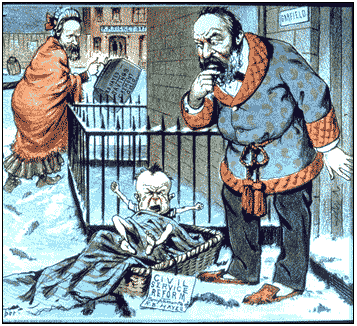
Puck
President. (Wikipedia.com)
Irony of ironies, it was General Garfield – who hadn’t sought the nomination – who won it. Grant’s defeat angered Conkling. He didn’t think any better of Garfield than he did of Hayes. To many Grant Republicans, the Democratic nominee, General Winfield Scott Hancock, looked like a winner. Roscoe Conkling thought James Garfield was a beaten man. That wouldn’t be so bad; he could run Grant again in 1884.
So, as in 1876, Conkling did not go out of his way to support the 1880 national ticket. He troubled the nominee with his demands over control of New York appointments and cabinet appointments in a future Garfield administration. Once again, Conkling’s self-interest guided his thoughts and actions. Conkling and Garfield met on more than one occasion after the surprise Republican nominee became the surprise Republican victor. Conkling’s insistence that he control New York patronage was an irritant and a warning to the President-elect.
Garfield was determined to avoid what Hayes had gone through. When Garfield appointed William Robertson to be the new Collector of the Port of New York, a political battle between the new president and Conkling rivaled anything that had gone on between Conkling and Hayes. It was a months-long battle of wills that led Conkling to resign from the Senate, in the belief that he would be reelected, and thereby be placed in a stronger position to defeat the Robertson nomination and prevail over Garfield. Conkling’s gamble failed. Republicans in the New York Legislature were not about to defy their own president. Conkling was not reelected.
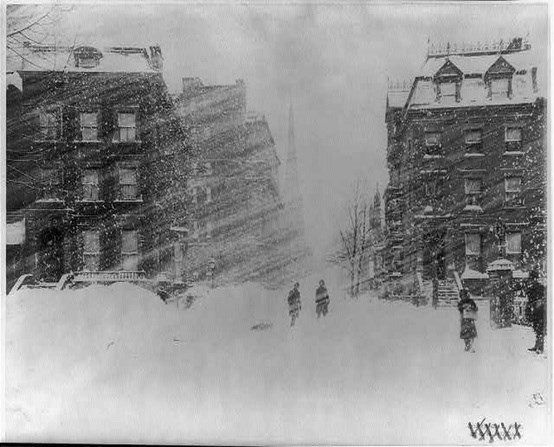
Library of Congress
Meanwhile, a demented Charles Guiteau, having followed the course of the Garfield- Conkling fight in the press, assassinated the President. His distorted sense of reality led him to believe that removing Garfield would reunite the Republican Party – and save the country.
The combination of political defeat and Guiteau’s bullet brought Conkling’s political career finally and irrevocably to an end. Conkling acknowledged as much when he said after Garfield’s death, “How can I speak into a grave? How can I battle with a shroud? Silence is a duty and a doom.” Later he said, “I am done with politics now and forever.” He meant it.
After 1881, Conkling devoted himself to his law practice. Among his clients were financier Jay Gould, and the young inventor, Thomas Edison. He was a defense lawyer in the Supreme Court case, San Mateo County vs. Southern Pacific Railroad. It was a landmark case in which the Supreme Court declared that the “equal protection” clause of the 14th amendment was intended to protect corporations as well as individuals.
Sunday, March 11, 1888 was a miserable day in New York City. A heavy rain turned into sleet, and the sleet into snow. It was not long before the city was a mess, with traffic stopped, the elevated railway disabled, and shops closed. The next day the wind gusts were clocked at 75 mph. After spending the morning in court, Roscoe Conkling trudged two-and-a-half miles through huge drifts of snow to his home. He wrote late, “I had an ugly tramp in the dark…drifts so high that my head bumped against the signs… and fallen telegraph wires.” Upon arriving home, he collapsed.
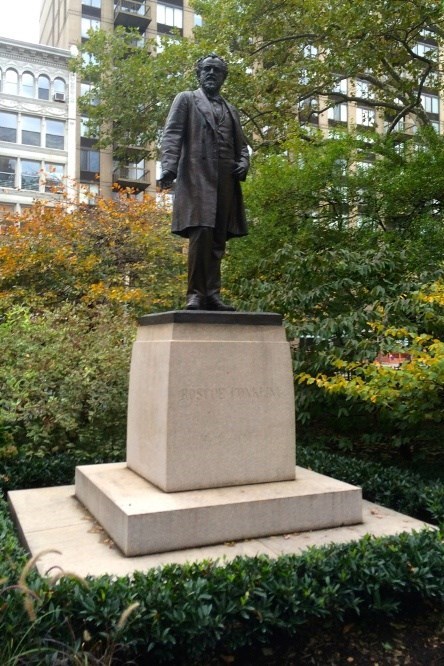
www.nycgovparks.org
Soon he was confined to bed, the victim of an abscess in his right ear. Ironically, Dr. D. Hayes Agnes, who had attended President Garfield, was called to Conkling’s bedside. By early April, an operation was necessary. A hole was drilled into Conkling’s head with a mallet and chisel to relieve a buildup of pus. It was hoped that the strong, athletic Conkling would pull through. He did not. He fell into a coma and died on April 18, 1888, at the age of 58.
What could be made of this man who once so towered over his competitors? The noted agnostic Robert Ingersoll eulogized Conkling, acclaiming him as a man who “stood for independence, for courage, and above all for absolute integrity …Roscoe Conkling was an absolutely honest man.”
This was not the view of all men at the time, and Conkling’s reputation remains largely negative because of all the controversy that he stirred in defense of his political machine. True, he could be principled, as when he urged President Grant to veto the inflation bill of 1874 and when he sided with President Hayes over the appropriations riders. He took the high road when he stood by Mississippi Senator Blanche K. Bruce, as their white colleagues altogether avoided the first elected black member of that body.
Conkling’s poor reputation, however, remains. He contributed no lasting positive record. The economic forces that were transforming the United Stated were controlled by men like Gould and Fisk, Rockefeller, Morgan and Carnegie. It was a transformation that Roscoe Conkling did not attempt to understand or guide. Intra-party squabbles, not the welfare of the nation, preoccupied Conkling. He repeatedly “let himself be caught up in inconsequentials.” Why did he allow this? Was it a basic insecurity that drove Conkling to act as he did? Was he just a mean-spirited individual who needed to dominate others? Alas, herein lays a mystery.
What is clear is that in his battles with two successive presidents, Roscoe Conkling helped to forge the start of a new path for the institution of the presidency that would make it in our time the most influential and watched position in American politics – and the world’s. In this, Conkling’s career in politics, after more than one hundred thirty years, still echoes.
Written by Alan Gephardt, Park Ranger, James A. Garfield National Historic Site, July 2013 for the Garfield Observer.
